
Agenerous spritz of “his” or “hers” perfume was once considered as the ultimate way for men to exude their manliness and women to waft their femininity.
But now the appeal of stereo-typically gendered smells is firmly in decline, as consumers are developing a nose for high-end unisex perfumes and buying perfumes designed for the opposite sex.
A new wave of intoxicating genderless perfumes is resulting in a boom in sales of high-end fragrances, sales figures indicate.
John Lewis said it had seen a 35 per cent year on year increase in bottles of perfume worth over £100.
Le Labo, a luxurious – but niche – brand which appears to be at the helm of the trend, sells unisex perfumes only.
Its fastest growing fragrance is Santal 33, first popular among fashion front-row types, now being sniffed out by British consumers who are able to stomach its £175 price tag.

Branding surrounding such perfumes is a far cry from the traditional James Bond in a bow tie versus girl in a pink dress perfume branding, with claims that Santal 33 “would intoxicate a man as much as a woman”.
Its makers claim it is inspired by the image of the man and his horse in the old Marlboro cigarette adverts, who Le Labo’s founders see as representing “personal freedom”.
It comes as the idea of unisex or genderless clothing is at the centre of the cultural zeitgeist.
For example the recent launch of Zara’s “ungendered” range, which consisted of eight pieces; plain T-shirts, hoodies, jeans and the like in grey, white and navy.
According to Estee Lauder, which recently bought niche brand Le Labo, certain specific ingredients carry deep gender associations, for example Iris, which has historically been used a lot in make-up products like face powders for its fineness and soft smell.
But now it says niche brands are tying these ingredients to new terms which are less gender-specific.
A spokeswoman said: “An Iris note can convey ‘sophistication’ or ‘smoothness’, a Jasmin note can bring ‘luminosity’ or ‘seductiveness’ to a fragrance – qualities which can appeal to everyone.
“Niche brands, for the most part, pride themselves on eliminating the gender construct in favour of focussing on the very fluid beauty of different combinations of ingredients, and therefore speak to the inner dialogue of the discerning scent shopper, who will consider this a more ‘purist’ and therefore more luxurious and artisanal approach.”
She added that the group had also seen a rise in shoppers using scents marketed at the opposite gender.
For example its Modern Muse Nuit fragrance, which features a heady Rum Accord with Musk and Jasmin has proved popular among its male customers, with counters reporting high levels of male interest.
Matt Leeser, John Lewis Head of Buying for Beauty & Wellbeing: “We have seen a surge in customers looking for a unique and different scent wanting to upgrade to new, interesting fragrances at the more premium end of the range.”
[“source=telegraph”]
